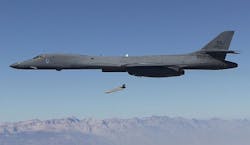Lockheed Martin to build stealthy cruise missiles to attack high-value and relocatable targets
JASSM is a 2,000-pound class weapon with a penetrator and blast-fragmentation warhead. It uses precision routing and guidance in adverse weather, day or night, using an infrared seeker in addition to the anti-jam GPS to find a specific aim point on the target.
Officials of the Air Force Life Cycle Management Center at Eglin Air Force Base, Fla., are asking the Lockheed Martin Missiles and Fire Control segment in Orlando, Fla., to provide Joint Air-to-Surface Standoff Missile (JASSM) production.
JASSM is a long-range, conventional, air-to-ground, precision standoff missile for the U.S. and allied forces that is designed to destroy high-value, well-defended, fixed and relocatable targets.
The JASSM’s significant standoff range keeps air crews well out of danger from hostile air defense systems, Lockheed Martin officials say.
Related: Lockheed Martin wins $34 million contract to integrate JASSM onto Finnish Air Force F-18
The JASSM has a stealthy airframe that makes it extremely difficult to defeat, Lockheed Martin officials say.
JASSM can be fired from several different aircraft, including the B-1, B-2, B-52, F-16, and F-15E. Internationally, JASSM is certified on the Royal Australian Air Force’s F/A-18.
Looking to the future, Lockheed Martin is working on the JASSM to enable the missile to fire from U.S. and international versions of the Lockheed Martin F-35 Lightning II joint strike fighter aircraft and other international military aircraft.
On this contract Lockheed Martin will do the work in Troy, Ala., and should be finished by June 2018. For more information contact Lockheed Missiles and Fire Control online at www.lockheedmartin.com/us/mfc, or the Air Force Life Cycle Management Center at www.wpafb.af.mil.
